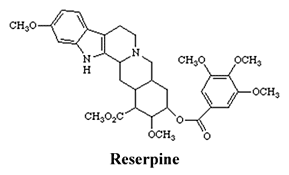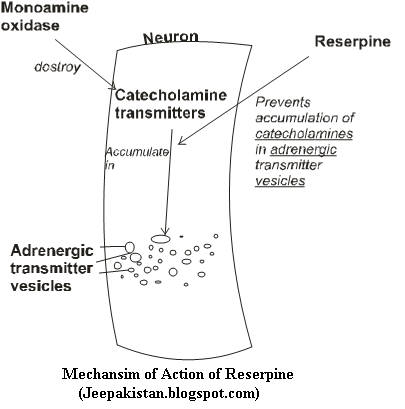Giolitti Andrea
Reserpine:The Treatment Of Hypertension As A Cause Of Depression
DESCRIPTION
Reserpine is an alkaloid extracted from the roots of a plant, Rauwolfia serpentine, a climbing shrub indigenous to India, genus of plants in the dogbane family (Apocynaceae). The flowers are small and usually white or greenish white in colour. Its role is as an antihypertensive and antipsychotic for oral administration. This drug has been used in the past, now less of its dangerous side effects (you may even commit suicide because of the depression). Reserpine was isolated in 1952. Reading from indian biomedical literature it was used for the treatment of mental disorders, fever and the bites of snakes and by Mahatma Gandhi as a tranquilizer. The first synthesis of the drug was accomplished in 1958. Reserpine was the first drug found that interfere with the autonomic nervours system (SNA).

Reserpine for veterinary use
Historical approach to reserpine discovery and its introduction in psychiatry":
All medical plants
THE MOLECULE
Its chemical name is methyl 18β-hydroxy-11,17 α-dimethoxy-3β, 20α-yohimban-16β-carboxylate 3,4,5-trimethoxybenzoate (ester) and its structural formula is:

Structure of reserpine in 3d
Chemical Formula: C33H40N2O9
Kegg drug
Reserpine is derived from tryptophan and it’s converted by tryptophan decarboxyles enzyme to tryptamine. The tryptamine is combined with secologanin by the strictosidine synthetase enzyme. Reserpine is formed by strictosidine with various enzymatic steps.
Reserpine
PHARMACOKINETICS
Reserpine is characterized by slow onset of action and sustained effects. Reserpine is extensively bound (95%) to plasma proteins. Reserpine is almost completely metabolized in the body, and only about 1% is excreted as unchanged drug in the urine.
MOLECULAR MECHANISM
Reserpine blocks the vescicular catecholamine transporter (VMAT) and this interference causes the loss of the role of the vescicles about capture and store biogenic amines. This happens in all the body, but the important effects are at the nervous system. Reserpine remains bound for prolonged periods of time. The adrenal gland is depleted less. Reserpine binds to the membrane vescicular irreversibly. Nerve endings lose their capacity to concentrate and store norepinephrine and dopamine. The Catecholamines leak into the cytoplasm, where they are metabolized by intraneuronal monoamine oxidase, and little or no active transmitter is discharged from nerve endings when they are depolarized. The overall result is a pharmacological sympathectomy.


Reserpine-induced reduction in norepinephrine transporter function requires catecholamine storage vesicles
Schuldiner et al (1993) Reserpine binding to a vesicular amine transporter expressed in chinese hamster ovary fibroblasts. J.Biol.Chem
Metzger et al (2002) Inhibitory effect of reserpine on dopamine transporter function. Eur.J.Pharmacol. 456 39. PMID
The loss of cathecolamines is important for the role anti-hypertensive of the drug. The reserpine in low doses can be used for treatment of hypertension because it blocks the various sympathetic actions (peripheral vascular resistance, blood pressure, heart, renine-angiotensin system).
hypertension
It must be taken into account that Reserpine enters in the brain and depletion of cerebral amine stores causes sedation, mental depression, and parkinsonism symptoms. As a matter of fact Mahatma Gandhy used reserpine as a tranquilizer and a sedative substance. This are the most important side effects that advise not to use reserpine for the treatment of anti-hypertension. The treatment anti-hypertensive mustn’t be standard for all the patients, but you can use many different drugs thank to the history and the genomic of the patient. The world is full of anti-hypertensive drugs, now the physician can choose the most important. The reserpine is usefull also for the treatment of agitated psychotic states (for example schizophrenia, Huntington corea, ipercinetic diseases ). The reserpine helps to less the renal and endocrine hypertension.
"The myth of reserpine-induced depression: role in the historical development of the monoamine hypothesis, 2003". Journal of the history of the neurosciences":http://www.ncbi.nlm.nih.gov/pubmed/12953623
Depressive States During Rauwolfia Therapy for Arterial Hypertension. A Report of 30 Cases
CONTRAINDICATIONS, ADVERSE REACTIONS AND DRUG INTERATIONS
Reserpine's strong inhibition of sympathetic activity allows increased parasympathetic activity. The effects of reserpine overdosage should be treated symptomatically.
High dose: hypersensitivity (purpura and rash), mental depression ( suicidal tendencies), active peptic ulcer and ulcerative colitis.
Adverse reactions: vomiting, diarrhea, arrhythmias , syncope, bradycardia, dyspnea, epistaxy, rare parkinsonian syndrome and other extrapyramidal tract symptoms, dizziness, headache, paradoxical anxiety, depression, nervousness, nightmares, dull sensorium, drowsiness, muscular aches, pseudolactions, weight gain, deafness, optic atrophy, hypersensitive reactions (pruritus).
Reserpine increases the gastrointestinal motility, so the physician must know the patient’s history (don't take reserpine if you had an peptic ulcer).
Reserpine administered parenterally during a pregnancy has been shown to be teratogenic. Reserpine crosses the placental barrier, and increases respiratory tract secretions, nasal congestion, cyanosis, and anorexia may occur in neonates of reserpine-treated mothers.
MAO inhibitors should be avoided or used with extreme caution. Concurrent use of tricyclic antidepressants may decrease the antihypertensive effect of reserpine.
The action of indirect-acting amines (ephedrine, tyramine, amphetamines) is inhibited when you had administrated reserpine.
Reserpine should be used cautiously with digitalis and quinidine.
A Phase 1 Parallel-Group, Double-Blind, Placebo-Controlled Cardiovascular and Behavioral Study Assessing Interactions Between Single Doses of Oral Reserpine and Intravenous Methamphetamine
Heslop and Curzon (1999) Effect of reserpine on behavioural responses to agonists at 5-HT1A, 5-HT1B, 5-HT2A, and 5-HT2C receptor subtypes. Neuropharmacology 38 883. PMID
THE MODERN USE OF RESERPINE
The use of reserpine has been discontinued in the UK for some years due to its numerous interactions and side effects. With the availability of newer drugs that are both effective and well tolerated, the use of reserpine has diminished because of its side effects, but there are now many studies in which administered reserpine and diuretics for treating hypertension (reserpine can cause significant sodium and fluid retention, and it should be given with a diuretic). Reserpine is one of the few antihypertensive medications that have been shown in randomized controlled trials to reduce mortality.
Five-year findings of the hypertension detection and follow-up program. I. Reduction in mortality of persons with high blood pressure, including mild hypertension. Hypertension Detection and Follow-up Program Cooperative Group
Effects of treatment on morbidity in hypertension. Results in patients with diastolic blood pressures averaging 115 through 129 mm Hg
Prevention of stroke by antihypertensive drug treatment in older persons with isolated systolic hypertension. Final results of the Systolic Hypertension in the Elderly Program (SHEP). SHEP Cooperative Research Group
Other use of reserpine:
Reserpine for the Treatment of Cocaine Dependence